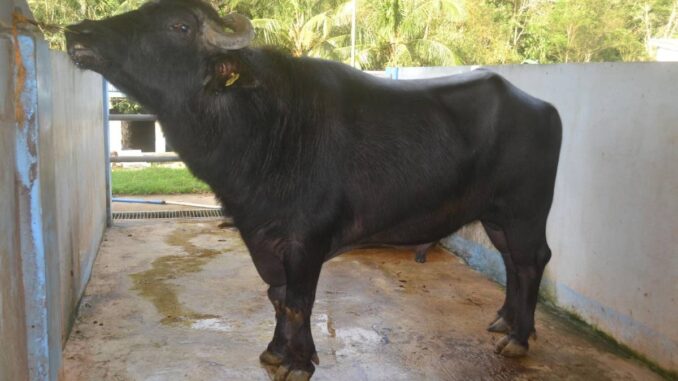
FILIPINO scientists have confirmed two species of domesticated buffaloes (Bubalus bubalis) that have traditionally been classified into two subspecies: swamp buffaloes and riverine buffaloes.
However, the recent study of the scientists provides evidence that these two are not subspecies but are instead distinct from each other.
The study, titled “Molecular Data and Karyotype Revealed Two Distinct Species of Domesticated Water Buffaloes in the Philippines,” offers valuable insights into the diversity of domesticated buffaloes and can guide conservation and management efforts, particularly in developing potential hybrids with desired traits. It was published in the Philippine Journal of Science.
A riverine buffalo (Bubalus bubalis Linnaeus, 1758). contributed photo
Swamp buffaloes (Bubalus bubalis carabanensis) are primarily used to assist farmers with tilling the land, transporting tools, and, alternatively, for meat, milk, hide and manure, which is used as organic fertilizer. On the other hand, Riverine buffaloes (Bubalus bubalis bubalis) are mainly used in milk production. In the Philippines, crossbreeding and backcrossing these two breeds on a large scale helps create animals with improved potential for milk and meat production despite their differences. Hybridization of swamp and river buffaloes has limited success, sometimes producing viable offspring that don’t achieve the desired traits.
“A team of researchers conducted an investigation to clarify the taxonomic designation of swamp and riverine buffaloes in the Philippines. They discovered that the DNA sequences of the genes from both swamp and riverine buffaloes are distinguishable, and that their chromosome numbers are different, affirming that they are two distinct species, not just subspecies of Bubalus bubalis,” the University of the Philippines-Diliman College of Science said.
The research team is composed of Ian Kendrick, Nelvie Fatima Jane Soliven, John Gregor Roño, Francis Fontanilla, Emerson Servo and Ernelea Cao of the UP-Diliman College of Science’s Institute of Biology, and Lilian Villamor, Therese Patricka Cailipan, Alexander Paraguas and Aivhie Jhoy Cuanang from the Department of Agriculture-Philippine Carabao Center.
“These results corroborate the observed differences in their appearances. Swamp buffaloes can be identified by the white or light gray markings on their lower jaw and brisket, known as a chevron, as well as their lighter skin and coat color compared to riverine buffaloes. They are also smaller, weighing between 325 and 450 kilograms, and have crescent-shaped horns. They are mainly used as draught animals,” said Villamor, citing data from her previous studies on buffaloes. “River buffaloes, on the other hand, are larger, weighing between 450 and 1,000 kilograms, and have curly horns. They are primarily raised for milk and meat production.”
According to the team, the Philippine native carabao, which is currently classified as Bubalus bubalis carabanensis, should be now considered as Bubalus kerabau Fitzinger, 1860. “The reclassification of the Bubalus bubalis carabanensis to Bubalus kerabau Fitzinger, 1860 supports earlier assumptions that riverine and swamp buffaloes are distinct,” added Fontanilla. “Confusions on the classifications of the two buffaloes have implications on the breeding program of these species.”
As their study was limited to examining the chromosomes of only swamp and riverine buffaloes, the researchers plan to include chromosomes from crossbred buffaloes in future studies to gain new insights into how these different types of buffaloes are genetically related and potentially improve the classification of the Bubalus bubalis.


Be the first to comment